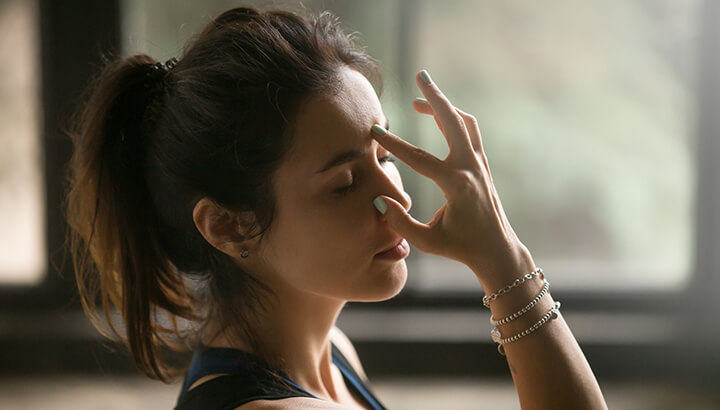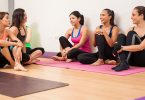Millions of Americans have trouble falling or staying asleep. In fact, the American Sleep Association estimates 50 to 70 million adults in the U.S. have a sleep disorder. These statistics range from snoring to unintentionally falling asleep during the day, to insomnia. Out of desperation, some people resort to taking prescription medication to help them sleep. Instead, try these five yoga poses right from your bed to help you fall asleep — and stay asleep — easier.
1. Easy forward bend
Cross your legs and gently bend forward. Your belly may come to rest on your legs once this becomes a comfortable position for you. If your hips are tight, try sitting on a pillow to elevate them and support the pose better. Allow your elbows, forearms and hands to rest on the bed and remain in this pose for several breaths. According to Vyda Bielkus, founder of Health Yoga Life, this pose is great for sleep and creates a sense of ease and release throughout the body.
Easy forward bend has been shown to reduce high blood pressure and fight insomnia. It’s also beneficial to the spine, shoulders and hamstrings, releasing tension in all of these areas. Other therapeutic benefits of this gentle bend include reducing anxiety, soothing headaches, relieving menstrual discomfort, reducing the symptoms of menopause and improving digestion.
2. Child’s pose
Come up to your knees and rest your buttocks on your heels with the tops of your feet against the bed. Then bend forward, allowing your torso to rest on your legs. Your forehead should rest on the bed as well, with your arms extended comfortably out in front of you or by your sides. Take some deep, long breaths as you remain in child’s pose.
This pose helps to relax the nervous system and relieve back and neck pain. Use it to bring more awareness to your breath as you lengthen the inhale and exhale. The close contact between your belly and tops of your legs provides the perfect way to connect the body and the breath. If you’re an expecting mother, chat with your yoga teacher about the best way to modify child’s pose — you don’t want to put added pressure on your belly.
3. Legs up the wall
As the name suggests, legs up the wall will require you to rotate in bed and put your legs up the wall, or up your headboard. Start by lying on your back and placing your feet on your wall or headboard. Shimmy your hips closer to the wall and then walk your feet up so just your heels are touching. Then extend your arms out to the side or place them on your belly. Remain here for five minutes, or longer if it feels good.
This pose helps lower your heart rate. It also allows the fluid that’s built up in your lower extremities to drain. If you’ve noticed that your feet are swollen at the end of the day, this is a fantastic pose for you. It also relieves lower back tension, a bonus for older adults. Studies have shown that this restorative pose can help reduce the negative effects of varicose veins, menopause, restless leg syndrome, fibromyalgia and metabolic syndrome.
4. Left-nostril breathing
In a seated position or while lying on your right side, gently block your right nostril with the thumb of your right hand, with your fingers extended. Take up to ten deep, slow breaths through your left nostril.
Left-nostril breathing helps the body and brain relax. This cool breath can reduce your blood pressure and bring calmness to your evening. You might even notice you fall asleep while practicing left-nostril breathing!
5. Corpse pose
Finally, we come to corpse pose. The pose is about complete relaxation, which can make it both challenging and rewarding. Lying on your back, allow your legs and arms to extend from the body naturally. Your feet should be about hip-width apart. Open your shoulders a bit, so they rest evenly on the bed and gently lay the backs of your hands on the bed. Your arms should be gently angled from your body. Soften all the muscles in your face, your shoulders, and so on, all the way to your feet. Stay in this pose for five minutes or longer.
Corpse pose encourages you to focus on your breath while calming the brain and relieving stress. You might also find that it helps relieve your headache, and lowers your heart rate and blood pressure. Enjoy this pose, and your breath in it, for a calmer start to your sleep.
What yoga poses have you found helpful when you can’t sleep?
— Megan Winkler







